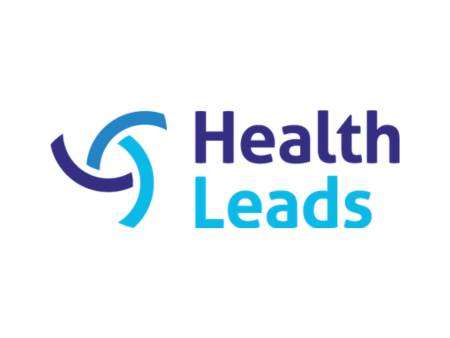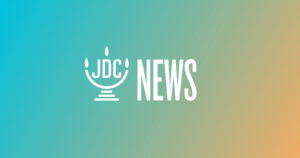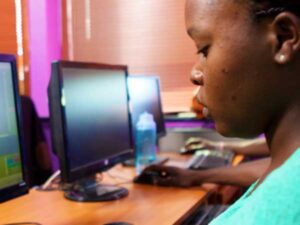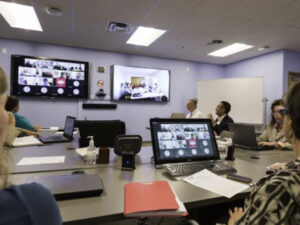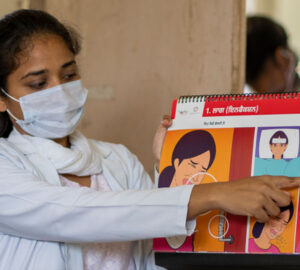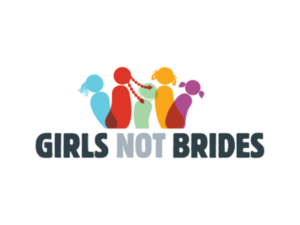Health Leads works locally and nationally to move racial health equity progress more effectively – in partnership and with communities taking the lead. The organization addresses complex health equity challenges, from maternal health to housing to food security.
Alexandra Quinn of Health Leads spoke with Alec Saelens on April 25, 2024. Click here to read the full conversation with insights highlighted.
Alec Saelens: Could you please describe the work that your organization does? What is the issue that you’re addressing, and how are you addressing it?
Alexandra Quinn: Health Leads works at the intersection of healthcare systems, communities, and public health, and our whole reason for being is to remove the barriers and systemic inequities that prevent people from being healthy. Our big, long-term vision is health, well-being, and dignity for every person in every community. While we don’t use this language a lot, we also think of ourselves as an innovation hub.
The history of Health Leads is important, both to honor the work we did before and acknowledge how we have learned from it. Our original focus when we started in 1996 was figuring out how to connect families to essential resources (or social determinants of health) at the point of care – because 80% of health happens outside of the healthcare system. Our founder Rebecca Onie did a TEDTalk about our previous model.
The original Health Leads program offered “help desks” that were integrated into care teams in hospitals and federally qualified health clinics (FQHCs). We co-created tools like the social needs screening toolkit to better understand what a person’s or a family’s needs are when they come in for a doctor visit (e.g. food, heat or housing). The help desk advocates would then connect the family to the resources they needed, and follow-up post visit to make sure they could access resources. We used college-age advocates to essentially play the role of a community health worker, working closely with social workers, because when Health Leads was started, community health workers were a lot less prevalent in the US than they are now.
Then, we asked: What if we got healthcare as a system to address social determinants of health as a standard part of care? That was what we called our “Grow and Catalyze plan”. We wanted to create several proof points that show healthcare can and should play a unique and critical role in screening for and addressing those essential resource needs.
We were successful in working with many healthcare organizations that were also deeply committed to this approach and doing innovative work – organizations like New York Health + Hospitals, Kaiser Permanente, Johns Hopkins, and Boston Medical Center. We partnered and were able to demonstrate with them that not only are people healthier when social determinants of health are addressed, but that the approach is actually replicable. And we were not the only organization or program doing this, there are many organizations and institutions that were focused on addressing social determinants at the point of care.
For all our success, we knew we were missing pieces. One of my favorite quotes around the term is from Dr. Tekisha Dwan Everette: “Social determinants of health is just a comfortable way to talk about racism.” I became CEO in the last year of the Grow and Catalyze plan, in 2018, and we pulled Health Leads up by the roots. We interviewed the staff (well, they interviewed each other), the board, our community advisory board and over 50 partners. We asked the question: “Now that we’ve gotten through these two phases of our work, if you could replant Health Leads, where would you replant it?” We assessed the various initiatives we were running at the time. We realized that we’d founded something that was working well, but had gaps in how we were collaborating to address issues that were deeply entrenched.
Dr. KimberlyDawn Wisdom from Henry Ford Healthcare said to us, “You’re living at an intersection of health care and communities.” She and others shared that our understanding of both were critical. That theme would be repeated, and this language is part of our new mission. In recent years, we’ve learned better how to work with and for public health as well.
The feedback came back loud and clear for us, and we realized we needed to change the goalpost. One of our board members at the time said to us, “It’s like you got to the top of one mountain with our focus on health care first, and you realized that was the wrong mountain.” But we couldn’t do what we did if we hadn’t done all the learning with and around healthcare.
We got so much good feedback from our healthcare partners, especially on who the community based workforce should be. Our friends in Contra Costa County, and in New York said we can’t plan health interventions around volunteer college advocates. They reminded us that community health workers exist, navigators exist, and family caregivers exist. We heard that directly from the community health workers and promotoras as well. They are already in the fabric of communities, in the fabric of our lives. They’re the ones who need to be empowered with tools, training, support, and whatever else is needed to navigate health in their community. That was a point of feedback that, along with our need to be designing differently, got us to our current strategy: doing community-led health work rooted in health equity.
I think one of the big mistakes that we made, and I made, before becoming CEO–and the former head of Boston Medical Center Kate Walsh said this, so I’m borrowing that from her– We didn’t say out loud enough that race and health have to be tied. They are totally inextricable in the United States. Part of the reason I said yes to this job was to squarely plant the flag on the fact that you don’t design anything that’s related to health or social needs without sharing power with community members and having them in the design seat. And we don’t talk about any of this or do any of this work without thinking about and talking about health equity. Because if you design with and for those who are most left out of the system, the system will change to the betterment for everyone.
We don’t want to do anything that someone else is doing (unless they ask us to), and we don’t want to do anything that can’t make a proof point to change systems. We want to do the things that push systems.
The other thing I’ll say is that’s what changed our mission. We put systemic inequities in our mission, and we pushed our vision out from saying it’s just about healthcare to saying, “We mean everybody.” One of our funding partners told us that we are always three to five years ahead of the market. So, we asked ourselves, how do we actually use all this power that we gained during our earlier days and push the market further to say, “Health equity and community design are at the center,” and then, fund that? Which brings us to the current approach.
Alec Saelens: Could you give me a concrete example of how the work you’re doing now is manifesting on the ground and benefiting the primary beneficiaries you intend to reach?
Alexandra Quinn: If you consider how we think about health and health equity, most people are focused on the point of care, risk behaviors, disease, and injury. Health Leads widely recognizes that the United States is a little bit addicted to downstream medicine and acute complex care. That’s also what costs us the most. How can we change that? And enable more healthy years for every citizen? The argument is that if you spent more money on social care and other things like prevention, we wouldn’t have as much disease, risk, and injury on this side. For years, we lived toggling between healthcare and the downstream and living conditions. It’s almost a Band-Aid.
One example of work on the ground is focused on food insecurity – both what is needed now, and how can you change the system? You need to get someone who is food insecure the food resources they need, and that’s 100% necessary. In NYC, we were asked by a local foundation and health care system to focus on access to the Women, Infants, and Children [WIC] program, which is a national benefit for those who are food insecure.
However, connecting women to WIC doesn’t address the social and institutional inequities that are causing food insecurity. There are many root causes of food insecurity and many inequitable barriers to accessing food support. For example, one of the leading causes of food insecurity is the immigration status of the mom, and this is true nationwide. Is she eligible as a non-citizen and even if she is, is she willing to access a benefit and risk deportation? And from a pure economics standpoint, there is an economic benefit to addressing both the immediate needs and root cause of essential resource gaps.
Our focus on how we think about living conditions and social and institutional inequities has four aims. One is around sharing power. How do we, in all decision-making, make sure that everything we design and do both in our own work and in our consulting considers community members and sustainable caregiving as a pull-through? What does the person who is experiencing food insecurity need and how to do we make the process easier for anyone helping navigate our systems of health? What’s the support? What are the barriers that we can help remove? What tools or training are needed? How do we make data and information equitable and available? How do ensure adequate investment in the people and the system so we can not only address the immediate need but also change the underlying process and policies that are causing harm?
Here’s how that approach plays out. Some of our community partners in New York City, including the Robin Hood Foundation, and some of our clinic partners told us that their Women Infants and Children’s benefit was not getting used. We were able to calculate that over 800,000 women who could be eligible for WIC were not accessing the program.
As we do with any initiative, we brought together multiple stakeholders, from the foundation to local benefit officers to moms to community health workers. Imagine you’re at a clinic doing a screening and then asking moms, both women who were pregnant, who had just given birth, and those who had a miscarriage, “Do you have food? What other essential resource needs do you have?” The CHW would check if they were eligible for WIC, and then would make the connection or “referral.” This is the typical process, but when we looked at the data, we saw that women still weren’t making it through that funnel. We went back to the moms and asked, “We made the referral; what happened? Tell us the story of how we can improve.”
Sometimes they’d say things like, “You told me I only needed to do two office visits to the WIC office, and they required three,” or, “You told me there’d be a Spanish speaker there on Thursdays and there was no Spanish speaker, so I couldn’t talk to anyone.” Story after story came through about institutional inequities stopping them from accessing the benefits. These are seemingly small and fixable process barriers that inequitably prevent accessing food.
Our team came together – our New York team was brilliant–and decided to put these stories and data together and present it to the WIC office for the state of New York. They told us they’d let us know when they reviewed it. Then they asked to meet with us every four to eight weeks for a year. Then the state of New York changed its entire WIC program based on four of the recommendations. This makes it sound simpler than it is. Deeply listening and co-designing is a slow process.
Alec Saelens: Wow.wic
Alexandra Quinn: When people have unmet needs, we focus on how we can meet the need. Then, how do we analyze the data and understand the policy ramifications at the same time to change the underlying system? Building on co-designing with our community partners to change the WIC program across NY State, when COVID-19 hit the NYC team asked a group of birthing people we were convening, “What else is important to you?,” it came to light that doulas getting into hospitals was a big problem due to COVID restrictions.
So we and our partners brought together this group of moms in a doula coalition and successfully advocated with the state to get doulas allowed into hospitals during COVID. If you aren’t familiar with doulas and maternal health, particularly Black maternal health, the literature is all there around how much Black, Indigenous, and Latinx moms have to fight both for their health and their rights in the hospital and how they have worse birth outcomes. Having a doula decreases their chance of having adverse incidences and increases many maternal and child health metrics.
From there, getting doulas reimbursed in the state of New York was the next part of our shared work. We co-created and launched a doula collective that worked towards getting Medicaid in the state of New York to reimburse doulas. Similar to the advocacy around WIC, it was community health workers, doulas, and birthing people doing the advocacy, not only us. Their reimbursement was slightly less than what we wanted, but we got it. And now we’re being asked to do the same thing in other states, but we’re not going to do it without doulas and moms by our sides or if there is already a backbone organization in place.
Alec Saelens: How do you measure progress and gather evidence of success, like those proof points, that you’re making a difference on a systemic level? What do you look at? What are the key metrics?
Alexandra Quinn: All of our work – whether we co-design an initiative from scratch or we are being hired as consultants or we are playing a convening or “backbone” role – is measured against four aims: 1) power sharing, 2) data equity, 3) sustainable care workforces and 4) community investment. We believe these are key ingredients that drive deep systemic change and get at the roots of inequities. If we can see change in these areas, starting with process measures, lives touched and eventually systems level measures such as a policy change or a tipping point around behavior and or investment, we believe it leads to both short term and long term change. Our initiatives have to meet all four of the aims, and we try to ensure our initiatives are not replicating something that already exists or where Health Leads could take money away from other organizations, especially local ones.
One thing I remember going back and forth on is when the doulas did not get reimbursed at the level the collaborative was aiming for, we asked: Does that count as a success or not? What does that mean? I think we landed on, well, they got reimbursed, so we can count it as success. But that’s actually not okay. Ideal success would be delivering on the standard the doula community set for themselves. But this is a great example of why equity work is a long game.
The other piece we measure in terms of impact is how we spread our learnings – not just to highlight our approach to increased awareness for Health Leads, but to help others tackling similar challenges move faster, and learn from both our wins and losses. We share our playbooks, the toolkits, we run webinars highlighting community voices and bright spots. We do surveys and try to understand how what we are sharing may impact their work.
The word scale often gets misused or over simplified in the social sector, especially when you are discussing innovation or changing the underlying process, behavior and systems. Health equity isn’t about a widget. What’s the data, support, what are the resources, what environmental, institutional and systemic barriers must be removed so anyone can thrive no matter what their gender, race, ethnicity or environment is? Just because a process to reimburse doulas in NY worked, that exact process with similar stakeholders may not be the right answer in another state. We think about how we share the best practices and learning so the more complicated process and policy changes can be replicated.
Alec Saelens: That’s fascinating. To recap, you learn about your own best practices, then distill that into a playbook framework that can both be replicated across your initiatives and be explained to other people doing work in this space. You also acknowledge that the playbook needs to be adapted to different circumstances to meet the moment and the situation.
I’d love to hear more about your systems-level work. What have you learned works best in achieving systems-level change? Could you share two or three nuggets of insight or wisdom about that?
Alexandra Quinn: One is that spreading practice should be done collaboratively and with a lot of humility and honesty. One example is our screening toolkit, launched in 2016 and updated in 2018. It’s been downloaded thousands of times mostly by healthcare organizations, so that means thousands of clinical teams are giving it to thousands of patients. It’s still our most widely accessed resource. But we give credit throughout the tool to the organizations that helped refine screening toolkits along the way. From our maternal health work to housing to primary care anytime we share or convey anything, we make clear this is not only us, that we have expertise, but it was done in partnership. We are also always willing to share others’ best practices and tools focused on systemic inequities and did a lot of that over COVID.
Another one of our biggest learnings has been the importance of sharing failure. Being really open and honest around where we didn’t do things well, which are many. As I mentioned, one big mistake we made as an organization was not better tying race and health together in all our work. When you share your mistakes and failures, you enable people to avoid those same failures, and to be okay with sharing failures because they help us and others learn faster.
The biggest nugget is we need to work differently if we want to improve the health of communities and change systems. As CEO in my first months, one of the things I was most frustrated with was the lack of collaboration across national and local organizations, across the funding and health care. There’s no way one organization or program or foundation alone is going to “solve health equity.” Towards this, just before COVID, we got together 15 different organizations to discuss how we can better work collaboratively, share power and increase impact.
As the pandemic unfolded, we said, “What do we want to work on together?” Dr. Durryle Brooks and Tené Hamilton Franklin rightly advocated for taking on COVID vaccine distribution, given the huge equity implications. So with the National Association of Community Health Workers, Partners in Health, CUNY, Families USA, Kresge, WKKF, CDC Foundation, School Based Health Alliance, and many others we built the Vaccine Equity Cooperative. It grew over time as we co-designed it to focus on access to information, collaboration and advocacy. This network of 8,000 and our partners had some incredible wins, including getting COVID testing kits out to thousands of community based organizations across the US and in partnership with others, successfully advocated to the White House and the US Department of Health and Human Services [HHS] to get pediatricians reimbursed for time spent educating families about COVID vaccines. HealthBegins also founded the Community Based Workforce Alliance at the same time, and we co-lead that with other partners. Both great examples of what you can do together.
We also started to actively ask: What is going well in communities during COVID? Then we started putting out webinars where you’d have someone from the Center for Disease Control [CDC] or from the White House talk about how local organizations were facing different COVID challenges. You’d have someone from a local community health worker organization talking about how it’s going. We had between 500-2,000 people show up for these webinars, creating a space to share what’s working. For example, on one chat, a nurse from Florida said, “It’s all well and good discussing how to talk about vaccines, but I’m in Florida, so I can’t say these words.” The head of a state NAACP said, “I have a toolkit for that.”
If you take people off mute, they share their best practices with each other in a forum that enables all parties to take the context of what we’re sharing and what that CBO is sharing, and for them to be honest about what wasn’t working, tailor that, and give feedback. We tried to create a space of belonging and shared learning for our community-based partners and really all of our stakeholders.
We just launched the next phase of this work, The Health Equity Community Collaborative. We are still focused on immediate issues and long-term challenges like mental health and children’s health – and are co-creating the work in real-time.
.Alec Saelens: Thanks for sharing all that. You’ve alluded to this already, but I’m going to pivot to asking you to dive more into the challenges. Can you discuss any challenges to the work that you’re doing, and what you’ve put in place to overcome those challenges?
Alexandra Quinn: One is funding, always. It is the hardest for our community-based organization partners who often have less access to national philanthropy. How do we make sure that we can fundraise for ourselves and for them in a moment when the community health workers and CBOs that saved the day during COVID are being quickly forgotten?
I think that is happening for two reasons. One is that we never really set up the system to share power locally. You’re seeing things like kids getting kicked off Medicaid, sometimes for technical reasons. One of the funding challenge’s root causes is people moving away from equity and moving away from trusting each other.
For us to do our work well, we need everybody to be able to share power around the table. And that’s hard. Often, you either can’t fund it, or people are exhausted. I see many, many people who need to heal, myself included. There’s been no repair from that. A recent Stanford Social Innovation Review on “Healing Systems” talks about how trauma impacts all of our systems. I recommend everyone read it.
While I appreciate that there is a better understanding of health equity and racial equity in the United States, what’s interesting is there’s a cumulative exhaustion of fighting inequities and that burden is deeply and inequitably carried.
I think another challenge is that the sector rewards a compelling story, often a hero-centered, individualistic story that leads to a very simple solution and then this big exciting impact on all these people. But if we want to change the underlying systems that impact our health and wellbeing, it’s a lot more complicated than that. It’s never just one person or one simple solution. That’s especially true if you’re working on health equity.
I think the challenge is understanding how to keep people engaged enough so they understand what the problem is. How do you keep your team excited about a huge problem that’s probably not going to be solved in our generation? How do you help them understand what the incremental wins and incremental progress mean to people on the ground while fighting this bigger system that wants to dumb it all down and has the wrong incentives?
There are so many amazing funders who get this completely, and we’re deeply grateful for them. They’re in the trenches with us. But we’re trying to get a lot more investors to look at funding the deeply unsexy work.
We have this project called the Makers Residency where we raised money and funded more than five chief program officers from across the country. We just gave them money and said, “What would happen if they had this pot of money and the time to work on a problem that’s been plaguing their community without restrictions? What if they could just be creative and have space to solve something?” It’s that kind of investing that we saw during COVID. All this money was getting put into the hands of people on the ground who knew how to solve their community’s health problems.
We are advocating for investing not only in immediate services, which is so important, but in supporting the community’s work in eradicating inequities. Those closest to the challenges know the solutions, and real equity work is sharing the power, making the space and time, and channeling resources to allow them to solve them.
Alec Saelens: Thank you so much for sharing your wealth of knowledge and experience. All the work that you’re describing is truly admirable. It’s been a pleasure.
Click here to read the full conversation with insights highlighted.
Alec Saelens is a former journalist who supports SJN and its partners track solutions journalism’s impact on society and the industry. In his former role, he researched and consulted on the connection between solutions journalism and revenue. He is co-founder of The Bristol Cable, the UK’s pioneering local media cooperative. Before SJN, he was a researcher and coach for the Membership Puzzle Project and an analyst for NewsGuard.
* This interview has been edited and condensed.
Read about other social innovations in health equity.

